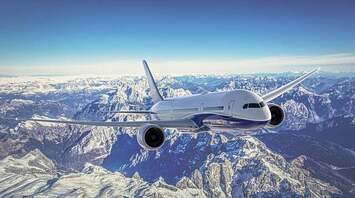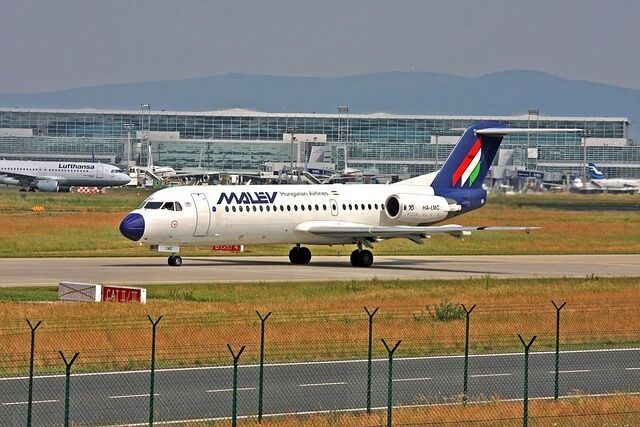Commercial and private jet speeds: from Boeing to Gulfstream

In a world where time is a precious resource, many travelers are looking for options to move quickly and comfortably. Perhaps you are flying to an important business meeting, want to spend a vacation with your family, or simply value every minute of your time. Interestingly, the average speed of commercial airplanes hasn't changed much over the past decades, but airplane companies are actively working on new technologies that will reduce travel time. Let's dive into the world of aviation and understand how fast commercial and private airplanes can get you to your destination, as well as learn about the prospects for supersonic flights.
Commercial airplanes
These aircraft are real workers of the sky, carrying millions of passengers and thousands of tons of cargo around the world every year. Unlike cargo airplanes, passenger airliners have specially designed compartments to comfortably accommodate people and their luggage.
Commercial aircraft typically fly at altitudes of 30,000 to 40,000 feet (9,000 to 12,000 meters) with an average cruising speed of about 550 miles per hour (885 km/h). Range varies by model and can reach 8,555 miles (13,768 km) without refueling.
Interesting fact. Did you know that the speed of commercial airplanes has not changed much over the past decades? This is because modern airliners are optimized for maximum fuel efficiency when flying at subsonic speeds.
Popular commercial airplane models are:
- Boeing 737. A best-seller among narrow-body airplanes, the Boeing 737 is used on short and medium routes around the world. Different versions of the 737 seat from 85 to 230 passengers and are known for their reliability and economy.
- Airbus A320. The main competitor to the Boeing 737, the Airbus A320 is also a popular choice for airlines operating short and medium-haul flights. The A320 seats up to 240 passengers and features modern design and advanced technology.
- Airbus A350 XWB. A next-generation wide-body aircraft, the A350 XWB is known for its passenger comfort, fuel efficiency, and range. The A350 can carry between 270 and 410 passengers depending on cabin configuration and is used on long-haul routes.
- Boeing 787 Dreamliner. Another member of the new generation of wide-body airplanes, the Dreamliner has been recognized for its innovative design, passenger comfort, and fuel efficiency. The Dreamliner seats 242 to 330 passengers and is used on medium and long-haul routes.
- Airbus A380. A true giant among passenger airplanes, the double-deck A380 can carry up to 853 passengers. The A380 is used on long-haul intercontinental flights and offers passengers unrivaled levels of comfort, including luxurious lounges, bars, and even shower rooms.
This list includes only a small fraction of the commercial airplane models that plow the skies. The variety of sizes, configurations, and features allows airlines to choose the best options for their routes and passenger needs.
Commercial Airplane Speed
|
Airplane |
Takeoff speed (mph) |
Cruising speed (mph) |
|
Boeing 737 |
160-180 |
500-550 |
|
Airbus A320 |
160-180 |
500-550 |
|
Airbus A350 XWB |
160-180 |
540-560 |
|
Boeing 787 Dreamliner |
160-180 |
560-600 |
|
Airbus A380 |
160-180 |
560-590 |
It is important to note that these speed values are approximate. The actual speed of a commercial airplane may vary depending on load, weather conditions, flight altitude and other factors.

Private jets
Synonymous with luxury, exclusivity, and freedom in the world of air travel. They are designed for those who value their time above all else and prefer a personalized approach to travel. Forget the hours-long queues, noisy lounges and restrictions of commercial airlines - private jets offer an unrivaled level of comfort and flexibility.
One of the main advantages of private jets is the ability to fly at higher altitudes than commercial flights, reaching 51,000 feet (15,500 meters). This avoids adverse weather conditions and airborne phenomena, allowing for a smoother and faster flight. In addition, private jets can land at smaller airports inaccessible to large airliners, giving travelers access to remote and exotic corners of the planet.
Popular private jet models.
- Dassault Falcon 8X. This state-of-the-art French business jet combines luxury, performance, and advanced technology. The Falcon 8X can carry up to 19 passengers at speeds of up to 685 mph (1,100 km/h), traveling up to 7,422 miles (11,945 km) without refueling. A luxurious cabin, advanced entertainment systems, and exquisite onboard service make the Falcon 8X the ideal choice for the most discerning traveler.
- Bombardier Global 7500. Bombardier Canada's flagship, the Global 7500 sets new standards for range and comfort for ultra-long-range business jets. The Global 7500 can carry up to 19 passengers up to 7,700 nautical miles (14,260 km) without refueling, connecting megacities such as London and Singapore without connecting flights. The spacious cabin, divided into four zones, transforms into a luxurious office, comfortable bedroom, or cozy dining room, depending on the wishes of passengers.
- Gulfstream G650ER. One of the fastest private jets in the world, the G650ER can reach speeds of up to 709 mph (1,142 km/h), traveling 7,500 nautical miles (13,890 km) without refueling. The G650ER can carry up to 19 passengers from London to Buenos Aires or from Los Angeles to Moscow, providing unrivaled levels of comfort and speed.
- Cessna Citation Longitude. This super-midsize business jet from Cessna is ideal for transcontinental flights. The Longitude seats up to 12 passengers and can travel up to 3,500 nautical miles (6,482 km) without refueling. Stylish cabin design, advanced technology, and the highest level of comfort make Longitude an attractive choice for business travelers and private individuals.
These are just a few of the brightest representatives of the world of private aviation, offering a wide range of options for comfortable and exclusive travel.
Private jet speeds
|
Airplane |
Takeoff speed (mph) |
Cruising speed (mph) |
|
Gulfstream G650ER |
180-200 |
680-709 |
|
Bombrdier Global 7500 |
180-200 |
610-650 |
|
Dassault Falcon 7X |
170-190 |
590-600 |
|
Cessna Citation X+ |
170-190 |
680-710 |
As with commercial aircraft, the actual speed of a private jet can vary depending on load, flight altitude, weather conditions and other factors. Nevertheless, private jets consistently offer an unrivaled level of speed, comfort and flexibility for those who value their time and strive for impeccable travel quality.
Factors affecting airplane speed
When talking about airplane speed, it's important to remember that it's not a constant, but a variable that is influenced by many factors. Here are some of them:
- Weight and load. The heavier the airplane, the more power is required to take off and maintain speed. The number of passengers, luggage, and fuel on board directly affect the weight of the airplane and, as a result, its speed.
- Weather conditions. Wind, turbulence, precipitation, and air temperature can all slow or speed up an airplane. For example, a tailwind can significantly shorten flight time, while a headwind can increase it.
- Flight altitude. At higher altitudes, the air is less dense, which reduces drag and allows airplanes to fly faster with the same level of engine thrust.
- Runway length. Heavy aircraft, such as the Boeing 747 or Airbus A380, require longer runways to gain enough speed to get off the ground.
- Technical condition of the airplane. The condition of an airliner's engines, airfoils, and other systems also affects its speed and overall performance. Regular maintenance and strict quality control are essential to ensure safe and efficient flying.
In addition to the above factors, other aspects such as flight path, air traffic, and even time of day can also affect flight speed. Pilots and air traffic controllers take all these factors into account when planning and executing flights to ensure the safety, efficiency, and comfort of passengers.

The future of flight speed
The aviation industry isn't standing still, and engineers around the world are working on new technologies that will make flying even faster, more efficient, and greener. Here are a few promising areas of development.
- Hypersonic airplanes. Imagine a jet capable of crossing the Atlantic in just a couple hours! Hypersonic technology, which allows for speeds several times the speed of sound, offers just such possibilities. Companies like Boom Supersonic and Hermeus are already working on commercial hypersonic airplanes that could be on the market in the coming decades.
- Electric airplanes. With growing concerns about climate change, there is an increasing focus on developing eco-friendly jets. Electric airplanes powered by batteries or hydrogen fuel cells could become a reality in the near future, offering silent and environmentally friendly short- and medium-range flights.
- Vertical takeoff and landing (VTOL) airplanes. Imagine an airliner that can take off and land vertically like a helicopter and then transition to horizontal flight like a conventional airplane. VTOL aircraft could solve traffic congestion and reduce travel time by offering fast and convenient transportation between and even within cities.
- Artificial intelligence in aviation. AI is already playing an important role in aviation today, helping to optimize routes, manage air traffic, and even pilot planes. In the future, AI will become even more integrated into the aviation industry, making flying safer, more efficient, and more affordable.
Advances in technology are opening up incredible prospects for aviation. It's safe to say that the future of air travel will be faster, more comfortable, and more sustainable than ever before.
In the world of aviation, speed is not just a number, but a complex concept influenced by technical capabilities, economic factors, and environmental concerns. Commercial airlines strive to find a balance between speed, comfort, and affordability, while private aviation focuses on speed and exclusivity.
Advances in technology offer tantalizing prospects: hypersonic flights, electric airliners, and vertical takeoff and landing aircraft could completely change the way we think about air travel. Although these technologies are still under development, they demonstrate humanity's desire to break boundaries and create a faster, more efficient, and sustainable future for aviation.
Whichever way you choose to travel – commercial flight or private jet – one thing remains the same: the sense of magic and delight of flying above the clouds and getting a bird's eye view of the world.



















